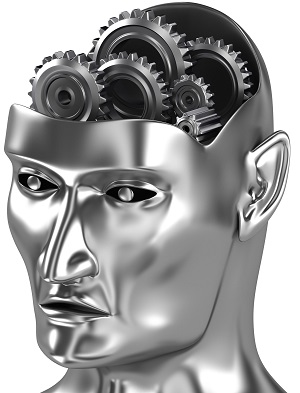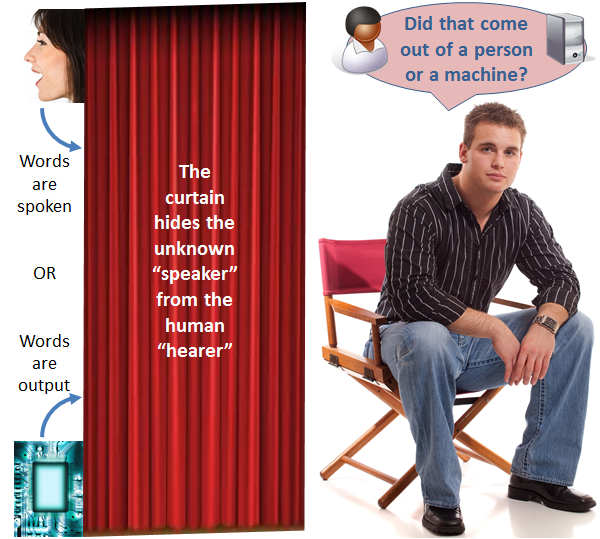22 May What Constitutes a Brain
By: Joe Roushar – May 2014
Mechanical Brains
 In its most general sense, the term mechanical brain could be applied to any man-made contrivance that is capable of functioning or generating information in some manner analogous to thinking. Under this broad definition, if the function were remembering an image (as we remember people’s faces), a camera with exposed film would qualify as a mechanical brain. If we were to interpret thinking as meaning solving a problem, determining a relationship, or integrating different bits of information to get a correct result, a pocket calculator could be considered a mechanical brain since performing mathematical computations requires intelligence.
In its most general sense, the term mechanical brain could be applied to any man-made contrivance that is capable of functioning or generating information in some manner analogous to thinking. Under this broad definition, if the function were remembering an image (as we remember people’s faces), a camera with exposed film would qualify as a mechanical brain. If we were to interpret thinking as meaning solving a problem, determining a relationship, or integrating different bits of information to get a correct result, a pocket calculator could be considered a mechanical brain since performing mathematical computations requires intelligence.
Artificial Intelligence (AI) systems can be used to lean about cognition or simulate it. “According to weak AI, the principal value of the computer in the study of the mind is that it gives us a very powerful tool … to formulate and test hypotheses in a more rigorous and precise fashion. But according to strong AI, the computer is not merely a tool in the study of the mind; rather, the appropriately programmed computer really is a mind, in the sense that computers given the right programs can be literally said to understand and have other cognitive states. In strong AI, because the programmed computer has cognitive states, the programs are not mere tools that enable us to test psychological explanations; rather, the programs are themselves the explanations” (Searle 1980). Searle’s comments may be said to favor “meaning-based” strategies and independent agency over strictly stochastic approaches and competence models. I will look at this dichotomy in later posts.
| Understanding Context Cross-Reference |
|---|
| Click on these Links to other posts and glossary/bibliography references |
|
|
|
| Prior Post | Next Post |
| Modeling After a Fashion | AI Domains and Approaches |
| Definitions | References |
| mechanical brain neuromorphism | Winston 1984 |
| think stochastic information | Turing 1936 Searle 1980 |
| memory intelligence | Bailey 1996 Fogel 2002 |
Now suppose the requirements for determining intelligence were stiffened: the input had to come from multiple sources, the mechanism needed to function with minimal intervention, and the result had to be difficult for humans to process. Even under those stiff criteria, a concept as old as the log and rope would qualify as a mechanical brain. You don’t know about the log and rope? This was an ingenious invention that truly demonstrates the creative capacity of the human brain. Ancient mariners tied a rope to a log and threw the log overboard astern. The number of kinks or knots generated by the spinning of the log in the ship’s wake told the sailors the speed of the boat.
This is an elegant mechanism, doubtless the result of keen observation and ingenious thinking. An indication of man’s progress in the new millennium is that modern mariners still measure speed in knots. While they no longer throw logs overboard, the concept based on the log and rope is still used today.
The Turing Test
Could a computer invent a speedometer? For that matter, could a computer invent anything? Creativity and the ability to learn are the most rigorous standards applied for distinguishing true mechanical brains from convenient gadgets or productivity tools. Remember, under the broad view, a camera or a calculator could be considered a mechanical brain. Once creativity and the ability to learn are factored in, neither qualifies – nor does any other machine ever built. Many say we will never be able to achieve artificial creativity. I will address this in another post.
The Turing Test (Turing, 1936) is a discriminator that uses a human judge to test the “intelligence” of a device. Basically, the Turing Test is just a blind product test similar to those done in laundry-detergent commercials. Instead of stained pairs of pants, however, the judge observes some form of output and tries to guess if a person in the loop produced the output or if it was done automatically. My depiction below uses words, natural language output, as the subject of the test.
Since humans can be deceived by ingenious devices, the Turing Test is hardly foolproof. Indeed, under the strictest interpretation of intelligence, a machine capable of learning as rapidly and fully as a person learns is difficult for most people to imagine. In this blog, I want to make it not only imaginable, but also foreseeable (the creative part will have to wait for my future blog). By focusing on advanced sensory processing and information storage and retrieval as the processes to imitate, even interpreting language by computer becomes possible.
In the Turing test, a person (the judge) at a terminal in one room that is hooked to a computer in another room types in questions at his terminal. Either the computer answers, or a person intervenes to provide the answer. A machine is determined to exhibit intelligence if the judge guesses wrong, thinking the computer answer was provided by a human, or the judge is unable to say one way or the other. There are many more questions to be considered, including whether the machine is intelligent, its program or neither.
I argue that the computer that wants to perform some cognitive tasks, such as human language understanding, needs to know everything, in context. Fogel (2002) suggests that the Turing test got us on the wrong track by needing to fool a person into thinking it is a human.
Parts of the Paradigm
The mechanical brain paradigm generally has three parts that decompose the considerations a solution architect would need to apply:
- FUNCTION (what it can do): a mechanical brain should be able do some of the same things as a biological brain, like learning, correlating, and accessing data. Function is primarily concerned with results.
- STRUCTURE (how its pieces are arranged): a machine would be more brain-like if its architecture (form) were similar to a biological brain (neuromorphic).
- PROCESS (how it derives results): processes in the mechanical brain would be more brain-like if they resembled the functional steps and flow of a biological brain. Process is primarily concerned with the flows of steps from input to output that lead to results.
To some degree, computers have accomplished the first two parts of the paradigm. Part three is presently difficult to judge. Although there has been a lot of speculation about how the brain processes information, little has actually been proven about its information-processing steps and flow. For the purpose of this blog, I will simply rely on assumptions I have introduced earlier, and if we later discover I am completely mistaken, I’ll apologize and start over again.
| Click below to look in each Understanding Context section |
|---|











